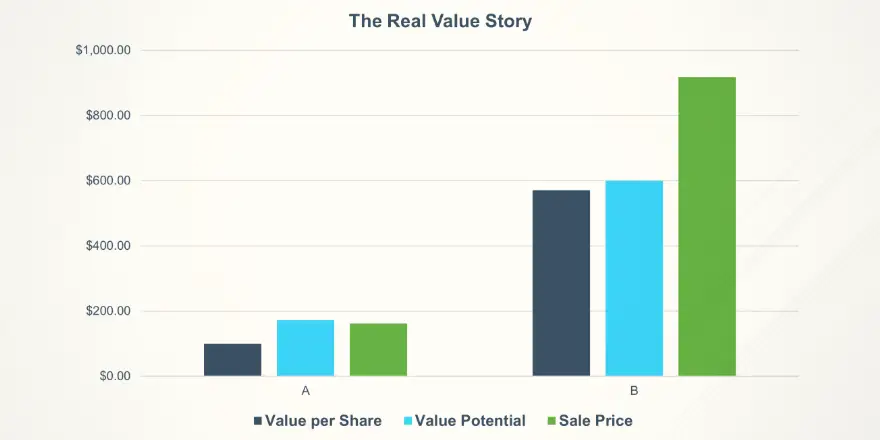Employee Ownership, Succession Planning, Business Value Acceleration
Understanding ESOPs – Register to our FREE webinar!
Understanding ESOPs – Register to our FREE webinar!
Employee Ownership, Succession Planning, Business Value Acceleration

In professional services, be it engineering, consulting, financial advisory, or beyond, measuring performance isn’t optional. Firms that thrive do so because they align day-to-day activity with long-term strategy. The challenge? Many firms either track too many metrics or focus on the wrong ones, leading to complexity without clarity.
That’s where the 3×3 KPI framework comes in. It simplifies performance management by focusing on three levels—business, team, and individual. In this guide, we’ll walk through each level, share anonymised examples from Client A and Client B, and show how to use a KPI dashboard to monitor performance in practice.
These KPIs reflect the overall health and strategic direction of your firm.
| KPI | Description | Target | Example |
|---|---|---|---|
| Net Labour Multiplier | Revenue generated per dollar of direct labour. | 2.5–3.0 | Client A: 2.5, Client B: 3.0 |
| Profit Margin | Net operating profit before tax as % of revenue. | 16.5–25% | Client A: 16.5%, Client B: 25% |
| Staff Turnover | Annual exits as % of total FTE. | <5% | Both firms target <5% |
These metrics help leaders assess profitability, efficiency, and workforce stability. For example, Client B’s 3.0 labour multiplier shows strong revenue generation relative to labour costs.
From a succession and valuation perspective, these firm-wide KPIs are critical. Buyers, investors, and potential successors look closely at financial stability, profit margins, and retention rates when assessing long-term value and transition readiness.
At the team or departmental level, KPIs measure how groups contribute to business goals.
| KPI | Description | Target | Example |
|---|---|---|---|
| Sales Conversion Rate | Ratio of successful proposals to total bids. | Track win/loss | Both firms monitor this closely |
| Project Profitability | Profit per project, assessed at milestones. | Positive ROI | Client A uses project debriefs and IMS |
| Customer Satisfaction | Net Promoter Score or Customer Effort Score. | NPS >10, CES >75% | Client B tracks both |
These KPIs ensure teams are not just busy but effective. Client A, for instance, uses project debriefs to catch scope creep and pricing issues early.
Strong team KPIs also reduce key-person risk — a common barrier to succession planning. By embedding performance measurement at the team level, firms demonstrate resilience and scalability, both of which enhance long-term business value.
Individual KPIs help employees understand their contribution to team and business success.
| KPI | Description | Target | Example |
|---|---|---|---|
| Utilisation Rate | % of time spent on billable work. | 75% | Client A sets this as a baseline |
| Revenue Target | Revenue generated relative to salary. | 2.5–3× salary | Client A: 2.5×, Client B: 3× |
| Peer Review Score | Feedback from colleagues. | >75% | Client B uses 360 reviews twice yearly |
These metrics build accountability and encourage growth. A consultant with a 2.5× revenue-to-salary ratio, for example, is making a strong contribution to profitability.
When linked to incentive schemes or equity allocations, individual KPIs also strengthen employee ownership models. Staff can clearly see how their contribution ties to firm performance and, ultimately, to the value of their shareholding.
Here’s an example of how a KPI dashboard can bring everything together across all three levels:
| Level | KPI | Current | Target | Status |
|---|---|---|---|---|
| Business | Net Labour Multiplier | 2.7 | 2.5 | ✅ |
| Business | Profit Margin | 18% | 16.5% | ✅ |
| Business | Staff Turnover | 6% | <5% | ⚠️ |
| Team | Sales Conversion | 45% | 50% | ⚠️ |
| Team | Project Profitability | $120K | $150K | ⚠️ |
| Team | NPS | 12 | >10 | ✅ |
| Individual | Utilisation Rate | 78% | 75% | ✅ |
| Individual | Revenue Target | 2.6× salary | 2.5× salary | ✅ |
| Individual | Peer Review | 72% | >75% | ⚠️ |
This snapshot highlights progress and risks at a glance, making it easier for leaders to act quickly.
The 3×3 KPI framework gives professional services firms a clear and scalable way to manage performance. By aligning KPIs across business, team, and individual levels, you create transparency, accountability, and strategic focus without drowning in data.
Here are some tips to implement the framework effectively:
Start small, measure consistently, and refine over time. With the right KPIs in place, your firm can not only track performance but also accelerate growth.
👉 Want a head start? Contact us to discuss how the 3×3 KPI framework can be applied in your firm.

Dr Craig West
 1 min read
1 min read
Oct 29, 2025 | Employee Ownership Business Value Acceleration
The Value of Ownership: ESOP Companies Achieve Strong Equity Growth
 2 min read
2 min read
Oct 16, 2025 | Resources Succession Planning
Business Exit Pathway Options Guide | Succession Plus
.webp) 2 min read
2 min read
Oct 14, 2025 | Resources Succession Planning
Legal Readiness Checklist for Business Exit Planning
 3 min read
3 min read
Oct 8, 2025 | Business Value Acceleration
Preparation Drives Premium | Strategy to Sale Results